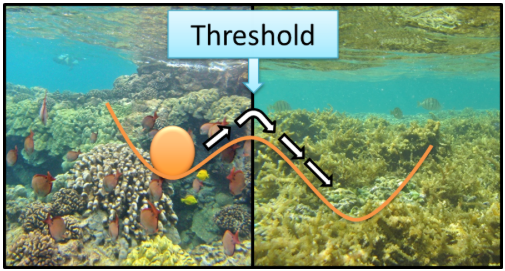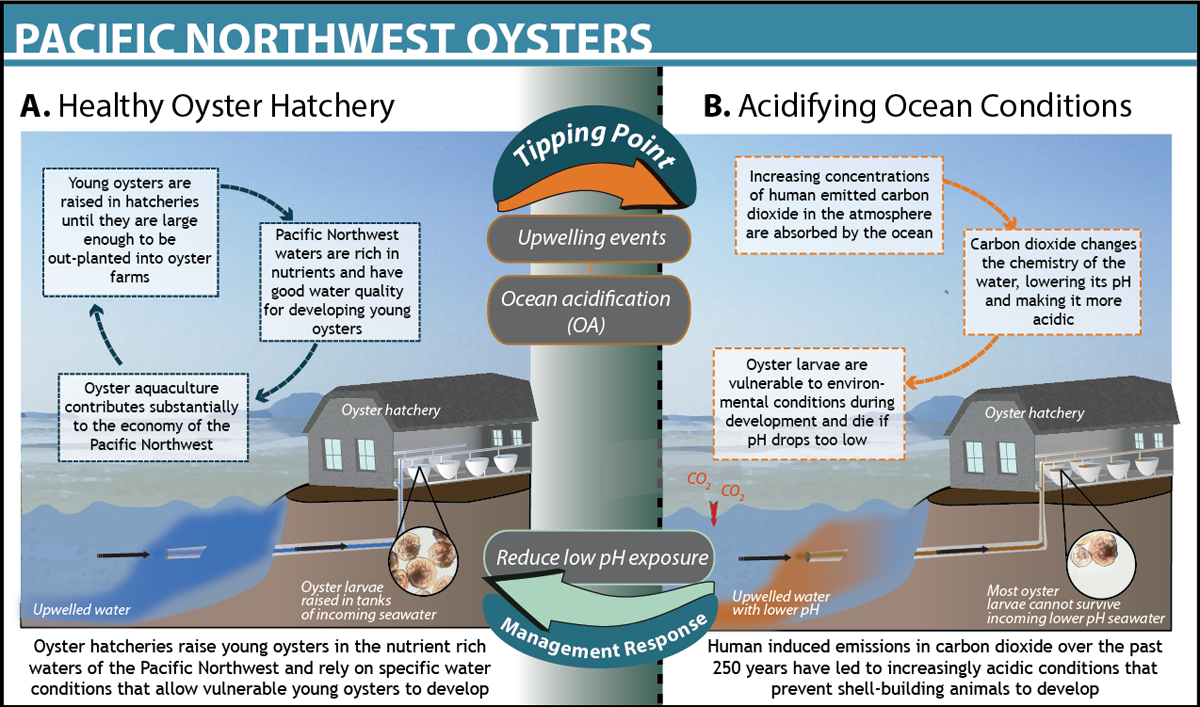
Check out the original blog post on OpenChannels at:
Part 2: Measuring effective threshold-based environmental management
The Ocean Tipping Points project is a collaboration of natural and social scientists, lawyers, environmental managers, and stakeholders working to understand what drives abrupt ecological shifts, and how they might be prevented or reversed. This is the second blog in a series in which we share the latest research and insights from our team of researchers.
A little stress can go a long way
In nature, one plus one does not always equal two. Sometimes, small changes in human pressures or environmental conditions can result in disproportionately large responses in the ecosystem—potentially even collapse.
As described in our previous blog post, ecosystems can respond to stressors in nonlinear ways, displaying ecological thresholds, colloquially known as “tipping points,” beyond which systems undergo dramatic change. For example, in the native longleaf pine forests of the US Southeast, the tipping point involves fire. Without frequent enough wildfire, fast-growing shortleaf pine invades, and the forest shifts rapidly into one that no longer functions in the same way – one that can’t, for example, provide essential habitat for the endangered red-cockaded woodpeckers that can only be found there.
Environmental managers can benefit from understanding these relationships between stressors and ecosystem response so that they can avoid tipping points or potentially restore ecosystems where thresholds have previously been crossed.

What does threshold-based management look like?
Our team undertook an empirical analysis of management decisions in threshold-based systems to determine whether particular attributes of these systems make managers more likely to meet their objectives. The results were published in the Nov. 24 special issueof Philosophical Transactions of the Royal Society—Biological Science.
We surveyed 51 case studies of threshold-based ecosystems worldwide, including lakes and estuaries affected by eutrophication, forests whose fire regimes have been altered, and coral reefs impacted by overfishing, among others. Each system and its associated management framework were evaluated using a set of 18 key attributes likely to affect management outcomes (based on Ostrom’s socio-ecological governance framework), such as the size of the ecological region, the scale of management, the regulatory framework for making threshold-relevant decisions, and the existence of quantitative threshold data. We categorized cases as prospective or retrospective management, based upon whether management aimed to avoid or recover from crossing a tipping point.
Three conclusions arose from our data on threshold-based systems:
- Threshold management works. More explicit use of thresholds in management is strongly associated with better management outcomes.
- Responsive monitoring is crucial. Positive management outcomes are also associated with routine monitoring requirements in both retrospective and prospective cases.
- Scale matters. Threshold-based systems with smaller geographic areas are more likely to have good management outcomes.
These attributes may at first seem obvious. However, other ‘obvious’ attributes included in our analysis, including adaptive management, cost-benefit analyses, and binding legal agreements, were not significantly correlated with increased achievement of threshold-based management goals. Our empirical analysis therefore helps to prioritize those elements most likely to result in management decisions that successfully avoided crossing a threshold or were able to restore a ‘tipped’ system.
The first finding—that explicit threshold-based management performs better than threshold-blind management—supports managers’ increased integration of threshold-based science tools into ecosystem management. In fact, we found that the more managers integrate threshold-based tools, the better their outcomes: use of quantitative thresholds outperformed management based on known or suspected thresholds but without quantitative targets, and both outperformed management that ignored the presence of thresholds.
A steady flow of environmental data through routine monitoring—coupled with science-based decision-making—can increase the resolution with which managers may guide decisions, and our results provide empirical support for monitoring as a key investment for effective management.
In our study, management of geographically smaller systems had better outcomes in both prospective and retrospective cases. For example, Taylor Shellfish Farms, Inc. in Washington State is a commercial aquaculture facility that grows Pacific oyster spat (Crassostrea gigas). By managing a relatively small system the growers are able to monitor and control important drivers, like pH of the facility’s intake water, that affect oyster growth in non-linear ways (see diagram above).
While oyster aquaculture operations are an extreme example of small-scale management, and the oyster growers’ struggles with ocean acidification may eventually be swamped by drivers at a much larger scale (namely global climate change), they nonetheless fit the pattern that smaller systems tend to have better results with threshold-based management. What drives this – whether reduced biophysical complexity, fewer stressors, fewer overlapping management jurisdictions, simpler institutional structure or some combination of those – is up for debate. What our data makes apparent is that scale is a parameter of concern; at larger scales, jurisdictional and ecological complexity may overwhelm institutional capacity to address social-ecological thresholds. Future studies will shed more light on the impact of scale on threshold-based systems.
Implementing threshold-based management
Implementing routine monitoring of environmental variables on a timescale relevant to the threshold, emphasizing threshold-based management decision-making (such as setting targets for stressors that induce threshold ecological responses), and, where appropriate, using geographically small management units with frequent interaction among institutions and jurisdictions, may all assist managers in prioritizing their management strategies in threshold-based systems.
Our upcoming blogs will present in more detail some of the exciting new research coming out of our two case study regions that is helping us to further ground-truth this early research and to develop tangible policy guidelines based on our findings. We look forward to sharing our initial findings with you in the coming weeks.
To find out more about some of the case studies included in our analysis, explore our brand-new interactive case study map and read individual case study write-ups. For more on our management review, you can visit our project summary page or download the paper.
Photo credit: Footwarrior, Brian Nielson

